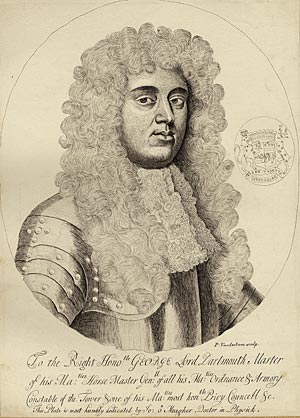
Archive sources
|
George Legge, 1st Baron Dartmouth (c.1647-1691)The Legge family gained their wealth through their support of the Crown from the Civil War to the 19th century, during which period they held a multitude of public offices. William Legge, who died in 1672, was the first Legge to rise to eminence as a result of his support for Charles I and Charles II and his friendship with Prince Rupert. He was appointed to various military posts including the governorship of the Oxford garrison in 1644. In 1701 the Legge family purchased an estate at Sandwell in what was then the south of Staffordshire. The core of the estate was the lands of the former Sandwell Priory, which included property at Great Barr and Handsworth. In 1711 they erected a mansion house at Sandwell. George Legge (c.1647-1691) had a distinguished naval career, beginning with service in the Dutch War, 1665-1667 with his cousin Sir Edward Spragg, Commander of the English rear squadron. In 1667 Legge was captain of the Pembroke and in 1672 captain of the Fairfax. He took part in the attack on the Dutch Smyrna fleet lying off the Isle of Wight in March 1672 which led to the declaration of war and he was also present at the English defeat by de Ruyter at Sole Bay on the Suffolk coast in May 1672. After this, he moved to the York and in the following year, 1673, he became commander of the Royal Katherine under Prince Rupert. Legge was appointed Lieutenant Governor of Portsmouth in 1670. Appointments as Lieutenant General of the Ordnance in 1672 and Governor of Portsmouth in 1673 followed. In January 1682 he became Master-General of the Ordnance and in December of the same year Charles II created him Baron Dartmouth. In 1683, Lord Dartmouth, now an Admiral of the Fleet, was entrusted with the evacuation of Tangier. When James II succeeded to the throne in 1685, Lord Dartmouth was made Master of the Horse and Governor of the Tower. In 1688, he was appointed commander of the Channel Fleet in place of the Catholic Sir Roger Strickland and in October 1688 he was ordered to intercept the Dutch fleet led by the Prince of Orange to prevent them landing in England. Following the successful `Glorious Revolution’, he was relieved of his command by William III and was later arrested on a charge of conspiracy. He died in the Tower of London in 1691. The RecordsRecords relating to George Legge’s work can be found within the family and estate papers of the Earls of Dartmouth, which are held at the Staffordshire Record Office (main collection reference numbers D742 and D1778). The records emanate from and reflect all aspects of George Legge’s public and naval career. They relate to Ordnance; Naval matters; the Tangier expedition, 1683-84; the Dutch invasion, 1688; Royal Stables, c.1675; Armoury, 1669-1685; and the Post Office, 1675-1682. The records that have been chosen for this exhibition focus on Legge’s work as Lieutenant and General of Ordnance; as leader of the Tangier expedition; and as commander of the Channel Fleet leading the navy against the threat of Dutch invasion in 1688. OrdnanceRecords include: gunpowder and saltpetre accounts; surveys of fortifications mainly at Portsmouth, Berwick upon Tweed and Holy Island (with detailed plans); lists of materials for work on fortifications and estimates of costs for their completion; detailed reports showing the state of the Naval Ordnance and surveys of stores in dockyards; and standing orders of Lord Dartmouth as Governor of Portsmouth. TangiersTangiers had formed part of the dowry of Charles II’s Queen, Catherine of Braganza, on their marriage in 1662, but had proved too great a drain on the exchequer. Although well situated strategically, it had major disadvantages as a naval base and the decision was taken to evacuate. The garrison personnel and other inhabitants of the town of Tangier were taken on board ships in Lord Dartmouth’s squadron. The houses, fortifications, town walls and mole were blown up and abandoned in March 1684. Records include: Ordnance supplies for Tangier,1664-1684; papers relating to preparations for the evacuation of Tangier; accounts and lists of town and garrison stores, 1664-1684; lists and orders relating to the evacuation of the Tangier garrison; petitions address to Lord Dartmouth as Governor of Tangier, mainly relating to debts and compensation, 1683-1684; lists of evacuation fleet and orders relating to victualling; ships musters for the evacuation of Tangier; and lists of soldiers under Lord Dartmouth’s command in Tangier,1683. Used together, these documents provide a fascinating insight into the lives of the inhabitants of the garrison and the town of Tangier; the planning and execution of the evacuation; and the destruction of the garrison in order to prevent its use as an enemy stronghold. NavalRecords include memoranda and accounts relating to prize ships; accounts relating to seamens’ wages, victualling, shipping of stores, provision of guns, and carpenters’ surveys of ships,1683 (these ships formed part of the expedition fleet to Tangiers). There are also records from Legge’s work as Admiral of the Fleet, leading the navy against the threat of a Dutch invasion in 1688. These include, for example, reports of the movements of the Dutch Fleet and copies of letters and petitions received by Lord Dartmouth on board the Resolution. There are also memoranda of the fleet concerning stores and victualling, the names of ships and where stationed, names of men pressed to service in the fleet, and some instructions issued by Lord Dartmouth. The images relating to George Legge are reproduced by kind permission of the Dartmouth Heirlooms Trust. |
